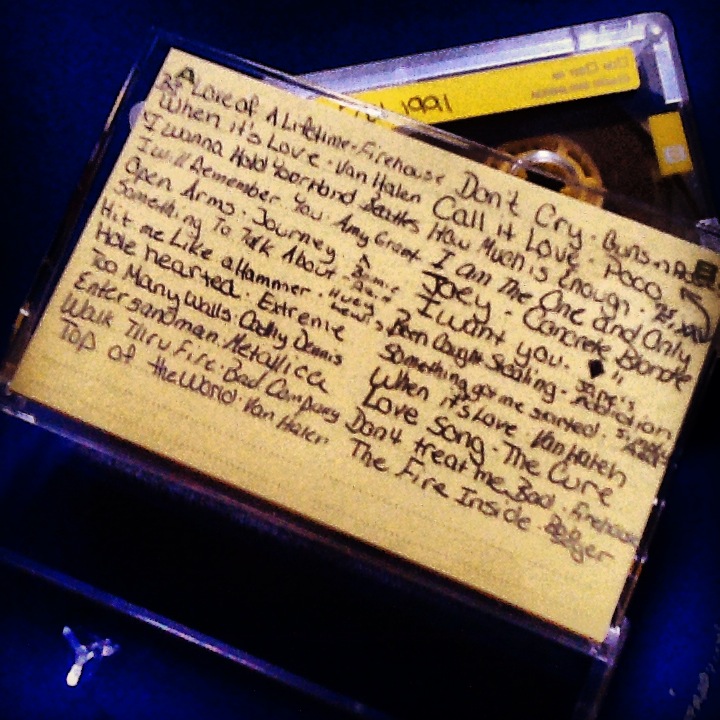When Tiffany sang “you put your arms around me and we tumble to the ground,” could I really have pictured a boy and girl tumbling down a hill—like, rolling down it log-style, maybe just before engaging in a potato-sack race?
I’ve spent a lot of time trying to imagine how I sang that song without once stopping to wonder what the boy and the girl did after they “tumbled to the ground.”
I had plenty of other moments of lyrical-content naiveté. I was in my 30s before the words to one of my favorite tunes from the era really hit me. Somehow, Cyndi Lauper’s references to men in tight pants–
But recently I’ve begun to realize there might be someone other than me to blame for the clueless way I interpreted the biggest songs of my childhood.
Maybe one reason it never occurred to me that Suzanne Vega’s “Luka” was about child abuse was that the person who introduced it to me probably prefaced it with a fun fact about the number of light bulbs in Las “Vega”s.
My hunch has solidified in recent months, as I’ve turned on the car radio on Saturday mornings to be greeted by the most significant of all the voices from my 80s childhood. A local pop station, Mix 96, plays vintage Casey Kasem countdowns, as stations all over the country have been doing.
Like many kids of that era, I collected songs by slavishly waiting next to my mini boom-box to hit “record” when Casey (or a local DJ) played my favorite song. But unlike most kids I knew, I had to rely on Casey (and radio in general) for my connection to the pop world. We lived on a farm, and out in the country, getting MTV was out of the question. (Though I doubt my parents would’ve sprung for cable if we could’ve received it. My dad forbid us from watching The Facts of Life because he believed the title was a reference to, you know, the “facts of life.”)
Racing up the stairs to my room after church and Sunday school to catch the Top 10 of Casey’s Top 40 was as much a ritual for me as church itself. As “the numbers got smaller and the hits got bigger,” I’d feel a little pang for any song that had “slipped a couple of notches,” as if the song itself had feelings, as if Whitney Huston or George Michael was sitting by a radio, too, hands clasped, desperate to see where he or she stood.
As the vintage countdowns have become a staple on weekend modern-day radio—and in the utterly surreal experience of re-hearing these childhood moments through adult ears—I’ve been astonished by the diversionary tactics Casey used to draw attention to anything but the actual content of the song. He must have known kids like me were clinging to our Walkmen, and wanted to protect us. (Or Westwood One told him to).
How else to explain the lead-ins I’ve heard when I’ve been relishing these re-broadcasts?
One weekend earlier this year I was driving across the state to visit my sister, and found myself chuckling, alone in my car, as Casey gave a teaser for Salt-n-Pepa’s “Push It” before the commercial.
Here was one of the first and only popular female rap groups, not to mention one who sung openly about sex. But when the commercial was over? There was Casey: “And now we’re up to a tune that was saved by a deejay.” His spiel detailed how the song was actually the B-side to another song, which a deejay didn’t think was a hit.
Later, to introduce Paul Carrack’s “Don’t Shed a Tear”: no mention of Squeeze or anything about Carrack’s pre-80s success. Instead, “And now we’re up to a song about ‘lacrimation’. It’s not illegal. It means ‘shedding a tear.’”
Now, on Saturday mornings in the kitchen when I tap the I Heart Radio app and tune in to a countdown, I can’t help but focus on the whitewashed way the scripts were written.
Before “Infatuation” by the ever-horny Rod Stewart? A long-winded anecdote about Rod’s manager receiving a pile of Billboard magazines due to a mailing mix-up. On a recent weekend, when it was time for a big hit by Whitesnake, (otherwise known as the band whose video introduced Tawny Kitean to the world), Casey gave a lesson on—you got it—snakes.
I will probably always suffer a metaphorical forehead smack every time I think about Suzanne Vega and Tiffany.
But I should remind myself that when Casey introduced me to “She Bop,” he probably said, “And now we’re up to a song that inspired a New York City woman to choose the name for her cat, a cat named Bop.”
Alison McGaughey was raised on the radio and remembers buying her first “album”–Wham!’s “Make it Big”–on cassette at a Woolworth’s in Keokuk, Iowa. Now a community college instructor and literacy-program coordinator, McGaughey writes about music, books, and Midwestern life at welcometoforgotonia.com. Her work has been published in Creative Nonfiction magazine, Midwestern Gothic, Hippocampus Magazine, and others, and has received awards from the Midwest Writing Center and Illinois Associated Press. Follow her on Twitter @Rural_Rose.


Sing it